N
naevius, -a, -um (NEE-vi-us) Freckled.
Nageliella (NAY-gel-ee-ELL-ah) A genus of two species of Mesoamerican orchids related to Epidendrum and Scaphyglottis. It was established in 1940 by Louis O. Williams, the name honoring the contemporary collector of Mexican orchids, Otto Nagel.
naked (NAY-ked) Wanting its usual covering or lacking certain organs as leaves, pubescence, etc.
nanellus, -a, -um (nan-ELL-us) Very dwarf.
nanus, -a, -um (NAY-us) Dwarf.
napiformis, -e (nap-i-FOR-miss) Turnip-shaped; more or less short-fusiform; broader than high and abruptly tapering both ways; napiform.
nascent (NAY-scent) In the process of being formed, as in meristematic tissue
nasutus, -a, -um (nas-OO-tus) Large-nosed.
natans (NAY-tanz) Floating.
natural: Lycaste x sulphurea is a natural hybrid between Lyc. deppei and Lyc. cruenta.
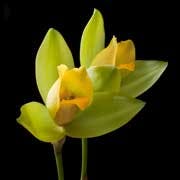
natural hybrid (NACH-er-uhl HYE-brid) A hybrid produced in the wild, in contrast to an artificial hybrid produced by man.
naturalized (NACH-er-uhl-eyzd) Said of plants from foreign areas that have become established.
natural selection (NACH-er-uhl SEE-lek-shun) The process of evolution that results in the differential survival and reproduction of those individuals best adapted to their environment.
navicularis, -e (nav-ik-yew-LAY-ris) Boat-shaped; cymbiform; navicular.
nebulosus, -a, -um (neb-yew-LOH-sus) Clouded; cloudlike; also applied to a plant found growing at a high elevation.
necrotic (ne-KROT-ik) The condition of cells and tissues killed through disease or injury.
nectar (NEK-ter) The saccharine secretion of a plant that rewards the animal vectors that pollinate the flower.
nectariferous (nek-tar-IF-fer-us) Nectar-bearing.
nectary (NEK-tar-ee) A nectar-secreting organ or part, such as the spurs of many orchids.
neglectus, -a, -um (neg-LEK-tus) A plant hitherto disregarded or overlooked.
nemoralis, -e (nem-oh-RAY-lis) Growing in groves or shady places; nemoral.
neo- (NEE-oh) A prefix meaning new.
Neobathiea (nee-oh-BATH-ee-a) There are seven epiphytic species in this genus native to Madagascar and the Comoros. Schlechter founded the genus in 1925, naming it in honor of Henri Perrier de la B—thie, who authored the Orchidaceae of Madagascar.
Neobenthamia (nee-oh-ben-THAM-ee-ah) A monotypic genus of terrestrial African orchids. Related to Polystachya, it was described by Rolfe in 1891, honoring the English botanist George Bentham.
Neocogniauxia (nee-oh-kohn-YOH-zee-ah) A genus of two West Indian orchids originally thought to be related to Laelia, it was established in 1913 by Schlechter and dedicated to the Belgian botanist Alfred Celestin Cogniaux; it accommodates the species formerly known as Laelia monophylla and L. hexaptera. Neocogniauxia is now known to belong to the Pleurothallidinae.
Neoescobaria (nee-oh-ess-ko-BAR-ee-a) The two epiphytic species in this genus come from the Andes in South America. Garay described the genus in 1972, naming it honor of the well-known Colombian orchid grower Don Gilberto Escobar R.
Neofinetia: Neofinetia falcata is the single species in the genus, which is now considered a Vanda.
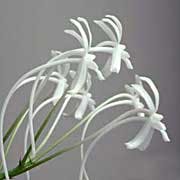
Neofinetia (nee-oh-fin-EH-tee-ah) A monotypic genus of epiphytic orchids from Japan, Korea and the Ryukyus related to Ascocentrum and resembling Angraecum, but this is now considered a Vanda. The genus was established by H.H. Hu in 1925 and dedicated to M. Achille Finet, a French botanist who worked on the orchids of China and Japan.
Neogardneria (nee-oh-gard-NEHR-ee-a) A monotypic Brazilian genus. Schlechter founded the genus in 1921, naming it in honor of George Gardner, who collected orchids in Brazil in the early 1800s.
Neolauchea (nee-oh-LOWK-ee-a) See Isabelia.
Neomoorea: The only species in the genus is Neomoorea wallisii.
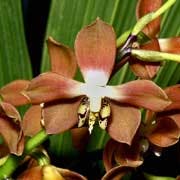
Neomoorea (nee-oh-MORE-ee-ah) A monotypic genus of epiphytic or lithophytic orchids from northern South America and Panama, allied to Houlletia, it was founded by Rolfe in 1904, being dedicated to F.W. Moore, curator at Glasnevin and an orchid fancier.
Neostylis (nee-oh-STY-liss) A hybrid genus between Neofinetia and Rhynchostylis created in 1965. Now that falcata is considered a Vanda, this genus would now be considered Vandachostylis.
Neotropical (nee-oh-trop-ih-kuhl) Of, pertaining to or designating the region comprising South America, the West Indies and tropical North America.
Neottia (nee-OTT-ee-ah) A genus of nine species of saprophytic orchids found chiefly in the boreal regions of the Old World. Related to Listera, Neottia was established by Linnaeus in 1735, the name alluding to the fancied resemblance of the clustered roots to a bird's nest.
Nephelaphyllum (neff-el-a-FIL-um) The 16 terrestrial species in this genus come from Southeast Asia, ranging from India east to the Malay Peninsular. Blume described the genus in 1825, coining the name from two Greek words for "cloud" and "leaf" to denote the mottling on the leaves.
nephroid (NEFF-royd) Kidney-shaped; reniform.
nervation (ner-VAY-shun) See venosus.
nerve (nerv) A vein or slender rib, particularly if not branched.
Nervilia (ner-VILL-ee-ah) A genus of 65 species of unusual terrestrial orchids from the tropical and subtropical areas of Asia and Africa and the Pacific noted for their rather attractive, solitary, heart-shaped leaves. It was described in 1826 by Gaudichaud, who attributed it to Commerson.
nervosus, -a, -um (ner-VOH-sus) Prominently nerved; nervose.
netted (net-ed) Marked with reticulated lines or veins.
neuter (new-ter) Said of a flower lacking reproductive structures.
neutral (new-truhl)A chemical condition of water or moist soil in which acid and alkaline constituents are exactly balanced; pH 7.
Nichols, William H. (1885—1951) Australian orchidologist and illustrator, author of Orchids of Australia (1951—1958).
Nidema: Nidema boothii is one of two species in this genus.
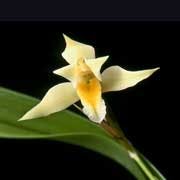
Nidema (nye-DEE-ma) The two epiphytic species in this genus range from Mexico south to Panama. Britton and Millspaugh founded the genus in 1920. The name is an anagram of the generic name Dinema.
nidulatus, -a, -um (nid-yew-LAY-tus) Nested; like or borne in a nidus or nest; nidulate.
niger, nigra, nigrum (NYE-jer) Black.
nigrescens (nye-GRESS-enz) Blackish; nigrescent.
nitidus, -a, -um (NIT-id-us) Shining; nitidous; nitid
nitens (NYE-tenz) Shining; becoming shiny.
nivalis, -e (niv-AY-lis) Snowy white; nival.
niveus, -a, -um (NIV-ee-us) Snowy; snow-white; growing near snow.
nobilis, -e (NOH-bil-is) Eminent; remarkable for fine qualities; noble.
nocturnal (nok-TER-nuhl) Of the night; used in reference to flowers that open after dark or having fragrance only at night.
nocturnus, -a, -um (nok-TERN-us) Night-flowering; blooming at night.
node (no-d) A joint on a stem or pseudobulb that normally bears a bract, a leaf, a whorl of leaves or a root.
nodosus, -a, -um (noh-DOH-sus) Having many joints or nodes; knotty; knobbed; nodose.
nodule (nah-dewyl) A small node
nomenclature (NOH-men-klay-cher) A set or system of names and naming.
notatus, -a, -um (noh-TAY-tus) Spotted; marked.
Notylia: Notylia barkeri is a popular miniature orchid.
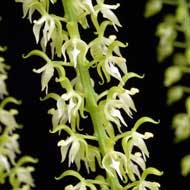
Notylia (noh-TILL-ee-ah) A genus of 50 species of compact, small-flowered epiphytic or lithophytic orchids from tropical America. It was established by Lindley in 1825, the name meaning "humpback," alluding to an unusual hump or callosity on the stigma, a character shared by its segregate genus Macroclinium.
nubigenus, -a, -um (new-bi-JEN-us) Born among the clouds; from a high elevation.
nucleus (NEW-klee-us) The central dense structure of a cell where DNA is replicated and transcribed.
nucleolus (new-klee-OH-lus) A sharply defined point in the nucleus of a cell where ribosomal RNA is synthesized.
nudus, -a, -um (NEW-dus) Naked; bare; nude.
nutans (NEW-tanz) Nodding; nutant.
nutrient (new-TREE-ent) A substance used or required for food by an organism.
nutrient solution (new-TREE-ent suh-LEW-shun) An aqueous solution of chemicals or natural substances required for growth or germination.
nutrition (new-TRIH-shun) The act or process by which an organism obtains energy and chemicals from the environment for survival or growth.




